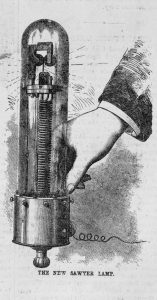 The “wonder of the 19th Century”, electricity, was introduced to Ballaratís householders in 1905. According to the newspapers of July 7th “An Up to Date Illuminant” had long been awaited in Ballarat, and the Edison Electric Company of 28 Armstrong Street North, anticipated “a big rush of orders for the supply of motive power and electrical appliances.” Percival E. Nettle, manager and Herman J. Tiedemann, engineer, both of the Edison Electric Company, urged the residents of Ballarat to inquire about the electrical appliances which they “would be pleased to explain.”
The “wonder of the 19th Century”, electricity, was introduced to Ballaratís householders in 1905. According to the newspapers of July 7th “An Up to Date Illuminant” had long been awaited in Ballarat, and the Edison Electric Company of 28 Armstrong Street North, anticipated “a big rush of orders for the supply of motive power and electrical appliances.” Percival E. Nettle, manager and Herman J. Tiedemann, engineer, both of the Edison Electric Company, urged the residents of Ballarat to inquire about the electrical appliances which they “would be pleased to explain.”
The question arose- “Which was better, Gas or Electricity?” One hundred years on the same question still rages! The Gas Company was a private corporation, the gas being turned on for the city of Ballarat on 17th July 1858 by Mr J.B Humffray. The Gas Company manager’s house is being demolished at present to make way for the new police complex at Dana and Albert Streets. The first directors of the Gas Company were Messrs J. Hepburn, M.J. Cummins, R. Belford, J. Gibb, R.B. Gibbs, E.A. Wynne and Dr Stewart. The engineers were Messrs Jones, senior and junior, and Mr S.E. Figgis. The secretaries were Mr G. Binstead and Messrs S. and W.H. Figgis, father and son. According to Withers in “History of Ballarat”, “Wesley church was the first public building lit by the company; but gas made by a Mr Courtis from gum leaves and oil had before then been used in Christ church, Bath’s hotel (now Craigs) and other places, and the old Charlie Napier was lighted about the same time with gas of a similar kind made by Mr John Gibbs. The Ballarat company’s revenue for the first year of supply was £12,000, and at the close of 1868 it was £24,600, with 1200 consumers.” In 1886 there were 2720 consumers.
Gas had been the main form of illumination in Ballarat since 1858 and on 15th July 1905 the Edison Electric Company asked, “Is Electric Light Cheaper than Gas or other Illuminants?” The “new system of lighting” was to be “ready within the month”, and “by using the latest types of glow lamps” Electricity would “not only compare favourably with Gas, but (would) come far cheaper in the end.”
The Meredian and Wybelite lamps were now available. They gave 55 and 25 candle power respectively, and took “less energy to produce that candle power than any lamp on the market.” The convenience of electricity was evident. Switches were usually placed near the door so the lights could be switched on and off easily, as compared with the gas lights which had to be relit if turned out.
Public interest was kindled, either by the new wonder or by the succession of advertisements and media coverage, and a Public Notice was issued by The Edison Electric Company in The Evening Echo, of 24th July which stated, “Owing to the large inrush of orders to be executed next month of the installation of ELECTRIC LIGHT and POWER, we wish to point out to citizens the necessity of seeing us immediately about their lighting.” “Call at once or ring up telephone No 408 and we will be pleased to submit estimates, which will cost you nothing.” Ninety years later it would be difficult to imagine life without “the new wonder”, ELECTRICTY!
